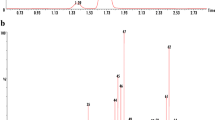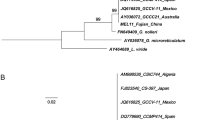Abstract
The production of dimethylsulfoniopropionate (DMSP) and its cleavage products (DMS) are well studied in phytoplankton worldwide. However, less is known about their sources, distributions, and impacts in the coast of China. We examined the production of DMSP and DMS in Phaeocystis globosa Scherffel and other benthic macroalgae from the South China coast in relation to environmental conditions. P. globosa was a harmful marine microalgal species and its bloom took place in the eutrophic waters along the South China Sea frequently. It also produced high content of DMSP at different growth stages, with the highest concentration usually observed in the stationary period. Moreover, the production of DMSP in P. globosa was significantly affected by salinity and temperature with the highest contents associated with high salinity (e.g. 40) and low temperature (e.g. 20°C). In field benthic macroalgae, there was also a marked difference in the DMSP of various species or different samples of the same species. Chlorophyll a contents were also determined for each macroalgal species. The highest chlorophyll a (238.7 ng/g fresh weight) was recorded in Chlorophyta Ulva lactuca at Guishan Island (Zhuhai), while the lowest value (1.5 ng/g fresh weight) was found in Rhodophyta Gracilaria tenuistipitata in Zhanjiang. Further correlation analysis indicated that there was no significant relationship between the content of DMSP and chl-a in macroalgae samples (P > 0.05). All the results suggested that the production of DMSP in marine algae was not only species- and stage-related, but also greatly affected by various environmental factors.
Similar content being viewed by others
References
Anderson D M, Cembella A D, Hallegraeff G M. 1998. Physiological Ecology of Harmful Algal Blooms. Springer-Verlag, Berlin.
Charlson R J, Lovelock J E, Andreae M O. 1987. Oceanic phytoplankton, atmospheric sulphur, cloud albedo and climate. Nature, 326: 655–651.
Groene T. 1995. Biogenic production and consumption of dimethylsulfide (DMS) and dimethylsulfoniopropionate (DMSP) in the marine epipelagic zone: a review. J. Mar. Syst., 6: 191–209.
Kathryn L, Van Alstyne, Melany P P. 2007. DMSP in marine macroalgae and macroinvertebrates: Distribution, function, and ecological impacts. Aquat. Sci., 69: 394–402.
Karsten U, Wiencke C, Kirst G O. 1992. Dimethylsulphoniopropionate (DMSP) accumulation in green macroalgae from polar to temperate regions: interactive effects of light versus salinity and light versus temperature. Polar Biol., 12: 603–607.
Kwint R L J, Kramer K J M. 1996. Annual cycle of the production and fate of DMS and DMSP in a marine coastal system. Mar. Ecol. Prog. Ser., 134: 217–224.
Lancelot C, Billen G, Sournia A, Weisse T, Colijn F, Veldhuis M, Davies A, Wassman P. 1987. Phaeocystis blooms and nutrient enrichment in the continental coastal zones of the North Sea. Ambio., 16: 38–46.
Michaud S, Levasseur M, Cantin G. 2007. Seasonal variations in imethylsulfoniopropionate and dimethylsulfide concentrations in relation to the plankton community in the St. Lawrence Estuary. Est. Coast. Shelf S., 71: 741–750.
Parsons T R, Maita Y, Lalli C M. 1984. A Manual of Chemical and Biological Methods for Seawater Analysis, Pergamon, New York. p.173.
Qi Y Z, Chen J F, Wang Z H, Xu N, Wang Y, Shen P P, Lu S H. 2004. Some observations on harmful algal bloom (HAB) events along the coast of Guangdong, southern China in 1998. Hydrobiologia, 512: 209–214.
Qi Y Z, Xu N, Wang Y, Lu S, Chen J F. 2002. Progress of studies on red tide in China—Studies on Phaeocystis globosa red tide and its DMS (DMSP) Production. China Basic Science, 4: 3–28. (in Chinese with English abstract)
Qu L Y, Lu S H, Gao C L, Li Y, Sun P, Sun X Q. 2008. Structure and sequence analysis of 18s rDNA and ITS gene of Phaeocystis isolate from the Bohai Sea. Advancens in Mar. Sci., 26: 200–206. (in Chinese with English abstract)
Schoemann V, Becquevort S, Stefels J, Rousseau V, Lancelot C. 2005. Phaeocystis blooms in the global ocean and their controlling mechanisms: a review. J. Sea Res., 53: 43–66.
Shen P, van Rijssel M, Wang Y, Lu S H, Chen J F, Qi Y Z. 2004. Toxic Phaeocystis globosa Strains from China grow at remarkably high temperatures. In: Steidinger K A, Landsberg J H, Tomas C R, Vargo G A eds. Harmful Algae 2002. Florida Fish and Wildlife Conservation Commission, Florida Institute of Oceanography and Intergovernmental Oceanographic Commission of UNESCO, St. Petersburg. p.396–398.
Stefels J. 2000. Physiological aspects of the production and conversion of DMSP in marine algae and higher plants. J. Sea Res., 43: 183–197.
Sun C J, Zhang M P, Sun Z S, Liu G. 1998. The measurement of DMSP concentration of microalga and macroalga in part of Jiaozhou Bay. J. Ocean Univ. China (Nat. Sci.), 28: 99–103. (in Chinese with English abstract)
Sunda W, Kieber D J, Kiene R P, Huntsman S. 2002. An antioxidant function for DMSP and DMS in marine algae. Nature, 418: 317–320.
Turner S M, Nightingale P D, Broadgate W, Liss P S. 1995. The distribution of dimethylsulfide and dimethylsulphoproprionate in Antarctic waters and sea ice. Deep-Sea Res., II(42): 1 059–1 080.
Veldhuis M J W, Wassmann P. 2005. Bloom dynamics and biological control of a high biomass HAB species in European coastal waters: a Phaeocystis case study. Harmful Algae, 4: 805–809.
Verity P G, Brussaard C P, Nejstgaard J C, van Leeuwe M A, Lancelot C, Medlin L K. 2007. Current understanding of Phaeocystis ecology and biogeochemistry, and perspectives for future research. Biogeochemistry, 83: 311–330.
Wang Y, Qi Y Z, Shen P P, Li S H, Lu S H. 2003. Effect of temperature and salinity on DMSP production in Phaeocystis globosa. Acta Hydrobiologica Sinica, 27: 367–370. (in Chinese with English abstract)
Author information
Authors and Affiliations
Corresponding authors
Additional information
Supported by the National Natural Science Foundation of China (No. 41006092), and Natural Science Foundation of Guangdong Province (No. 1015030101000002)
Rights and permissions
About this article
Cite this article
Shen, P., Qi, Y., Wang, Y. et al. Phaeocystis globosa Scherffel, a harmful microalga, and its production of dimethylsulfoniopropionate. Chin. J. Ocean. Limnol. 29, 869–873 (2011). https://doi.org/10.1007/s00343-011-0515-7
Received:
Accepted:
Published:
Issue Date:
DOI: https://doi.org/10.1007/s00343-011-0515-7




